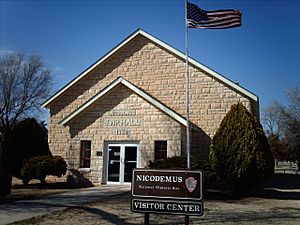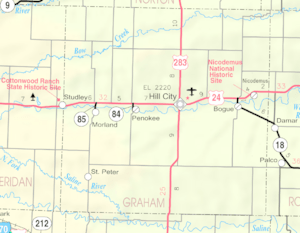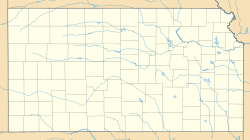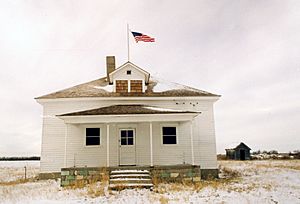Nicodemus, Kansas facts for kids
Quick facts for kids
Nicodemus, Kansas
|
|
|---|---|

Nicodemus Township Hall (2006)
|
|

|
|
| Country | United States |
| State | Kansas |
| County | Graham |
| Founded | 1877 |
| Named for | Nicodemus |
| Elevation | 2,018 ft (615 m) |
| Population
(2020)
|
|
| • Total | 14 |
| Time zone | UTC-6 (CST) |
| • Summer (DST) | UTC-5 (CDT) |
| Area code | 785 |
| FIPS code | 20-50550 |
| GNIS ID | 472219 |
Nicodemus is a small, historic community in Graham County, Kansas, United States. It is known as a census-designated place (CDP). In 2020, only 14 people lived there. The town was started in 1877. It is named after the Biblical figure Nicodemus.
Nicodemus is home to the Nicodemus National Historic Site. This site celebrates the only remaining western town founded by African Americans. These towns were created during the Reconstruction Period after the American Civil War. Every year, during the last weekend of July, former residents and their families come back to Nicodemus for fun celebrations and parades.
Contents
History
Why People Moved West
The founding of Nicodemus was part of a big move west in the late 1800s. New technologies and ideas helped people move. The Homestead Act of 1862 offered land to people who didn't have much money. A person could claim 160 acres of land. They had to live on it and improve it for five years. After that, they could buy it. Also, more railroads were built across the Great Plains. This made it easier to travel and create new towns.
Kansas was especially appealing to African Americans. Many lived in the South after the Civil War. Kansas seemed like a place of freedom and opportunity. This was because of people like John Brown and other abolitionists. Promoters like Benjamin "Pap" Singleton encouraged African Americans to move to Kansas. Nicodemus became a key destination for these new settlers. Railroads and steamboats offered cheap travel. Thousands left the South to escape hardship. They hoped to find economic chances and freedom in the West.
Starting Nicodemus in 1877
On April 18, 1877, a group of seven Kansans formed the Nicodemus Town Company. Six of them were black. W. H. Smith, an African American, was the first president. W. R. Hill, a white land expert, was the treasurer. Most of the group were former slaves from Kentucky. They wanted a new life. Their goal was to create the first all-black settlement on the Great Plains.
There are two ideas about how Nicodemus got its name. One says it was named after the Biblical figure Nicodemus. The other says it was inspired by a story of an African prince. This prince was taken into slavery but later bought his freedom. Hill chose the town's location. It was on the north bank of the Solomon River. This area was good for farming. The town itself was on a 160-acre plot. The whole township was 19,200 acres.
Smith and Hill worked hard to promote the town. They wanted to attract new settlers. They sent out flyers describing the land and its benefits. These flyers went to people in the South. They first tried to attract people with enough money to help the town grow. Residential lots cost $5, and business lots were $75. The promoters also charged fees to help settlers get started. These efforts worked. Groups of settlers came from Eastern Kansas and Kentucky. In 1878, the population reached about 600 people.
Early Challenges and Growth
In 1878, John Wayne Niles became the second president of the colony. Life in early Nicodemus was very tough. Some people left by mid-1878 because resources were scarce. Most settlers were very poor farmers. They arrived without money or supplies. They lacked tools like plows, wagons, and horses. This made it hard to farm the rough land. Some even used hand tools to make fields. There wasn't much timber, so settlers built homes from prairie sod. To earn money, some collected and sold buffalo bones. Others traveled far to work for the railroads. The town asked other communities, charities, and even the Osage tribe for help.
New groups of settlers arrived in Nicodemus in 1878–79. They came from Kentucky and Mississippi. Unlike the first settlers, they had resources. They brought horses, plows, farm equipment, and money. John W. Niles, a charity leader, took over as president. Under Niles, the town decided to stop asking for charity. They wanted to encourage hard work and self-reliance. The town also didn't want to become a destination for the Exodusters. These were thousands of poor black farmers moving to Kansas. Nicodemus leaders feared too many poor farmers would hurt the community.
Soon, the town began to grow. Businesses became successful. A hotel and two stores opened. A school and three churches were built. Social groups like the Grand Independent Benevolent Society of Kansans and Missouri held dances and parties. One event was an annual celebration of England's freeing of slaves in the West Indies. In 1880, Nicodemus hosted the election for the Graham County seat. However, the town lost to Millbrook.
Decline and Revival
After growing in 1879–80, Nicodemus began to decline after 1880. Many settlers didn't plan to stay forever and moved on. Not enough business lots were sold to keep the town growing. Years of bad harvests also caused the population to drop. By 1884, fewer than 50 people remained. Nicodemus also faced a legal fight over land ownership. A local land expert, Henry Miller, found errors in the town's land records. This meant the town didn't officially own the land. Miller's lawsuit threatened the residents' claims. But the case was dropped, and the town got its official title on June 6, 1886.
In 1886, the town started a new promotion campaign. The town's two newspapers, the Western Cyclone and the Nicodemus Enterprise, were key to this. The papers tried to attract both black and white people. They described the town's social clubs, activities, celebrations, and business chances. The town also worked hard to get a railroad route through Nicodemus. They voted to sell $16,000 in bonds to pay for this. But none of the three railroad companies (the Missouri Pacific, Union Pacific, and Santa Fe) built tracks to the town.
Nicodemus Today
The failure to attract a railroad ended Nicodemus's growth. Most businesses moved away. But the town remained a social hub for the local community. Groups like the Masons, the American Legion, and the Priscilla Art Club still held dances and events. The annual emancipation celebration remained important. In the 1920s, thousands attended this event. It included horse races, boxing matches, parades, and baseball games.
The Great Depression and the Dust Bowl greatly affected Nicodemus. The town's population dropped to as low as 40 people. The town received help from the Federal Land Bank and Graham County Farm Bureau. Because of the Depression, many families lost their land. They became tenant farmers, working land owned by others. Farmers also had to change their methods. They started growing tougher, drought-resistant crops. The falling population led to the post office closing in 1953. The school closed around 1960. Social organizations also shut down due to low attendance.
Starting in the 1970s, Nicodemus began to be restored. Former residents donated money to repair damaged buildings. New improvements were made. These included low-income housing, a 100-foot tall water tower, and paved main streets. These efforts helped save Nicodemus and rebuild its popularity. The town became a retirement spot for former residents. The Emancipation celebration was renamed Homecoming. It became a gathering for old residents to celebrate their history. It is still celebrated every year.
In 1976, Nicodemus was named a National Historic Landmark. By 2018, its First Baptist Church, African Methodist Episcopal Church, and other historic buildings were in poor condition. They could not be opened to the public. The AME Church was renovated and opened to visitors in 2021. At that time, Nicodemus had only 23 residents.
Geography
Nicodemus township covers 32.4 square miles. The town is located along Highway 24 in the Great Plains.
Climate
Nicodemus has four seasons because it is on the Great Plains. Summer is usually long and hot, with common thunderstorms. Spring and fall are short. Winter is cold. The town gets about 22 inches of rain each year.
| Climate data for Nicodemus, Kansas | |||||||||||||
|---|---|---|---|---|---|---|---|---|---|---|---|---|---|
| Month | Jan | Feb | Mar | Apr | May | Jun | Jul | Aug | Sep | Oct | Nov | Dec | Year |
| Mean daily maximum °F (°C) | 43 (6) |
47 (8) |
56 (13) |
67 (19) |
75 (24) |
86 (30) |
93 (34) |
90 (32) |
82 (28) |
69 (21) |
55 (13) |
43 (6) |
67 (20) |
| Mean daily minimum °F (°C) | 15 (−9) |
18 (−8) |
26 (−3) |
36 (2) |
48 (9) |
58 (14) |
64 (18) |
62 (17) |
51 (11) |
38 (3) |
26 (−3) |
16 (−9) |
38 (4) |
| Source: National Park Service | |||||||||||||
Demographics
| Historical population | |||
|---|---|---|---|
| Census | Pop. | %± | |
| 2020 | 14 | — | |
| U.S. Decennial Census | |||
The 2020 United States census counted 14 people in Nicodemus. There were 5 households and 0 families. The population density was about 16 people per square mile. There were 32 housing units.
Most residents were Black or African-American (78.57%). Some were white (14.29%). A small number were from two or more races (7.14%). About 14.29% of the population was Hispanic or Latino.
Of the 5 households, none had children under 18. None were married couples living together. None had a female head of household without a partner. All households (100%) had individuals living alone. About 20% of households had someone aged 65 or older living alone. No one in the population had a bachelor’s degree or higher.
About 7.1% of the population was under 18. Another 7.1% were 18 to 24 years old. About 42.9% were 45 to 64. And 35.7% were 65 or older. The average age was 59.5 years. For every 100 females, there were 75 males. For every 100 females aged 18 and older, there were 85.7 males.
Recreation
The Nicodemus National Historic Site is a main attraction in Nicodemus. Its Visitor Center has a bookstore and exhibits about the town's history. You can take walking tours or guided tours. These tours show the historic buildings and features of the town. The Nicodemus Historical Society and Museum is run by descendants of the original settlers. They offer tours to cemeteries, old homesteads, and school sites in the township. There is also a roadside park in town. It has a playground and a picnic area.
Education
The local public schools are part of the Graham County USD 281 school district.
Notable People
- Edward McCabe (1850–1920), town secretary, later Kansas State auditor
- John Wayne Niles (1842–?), early settler of Nicodemus and the founder of the all-Black Indemnity Party. He supported payments for slavery in the early 1880s.
- Veryl Switzer (1932–2022), football player for the Green Bay Packers, born in Nicodemus in 1932.
- Lulu Craig (1867-1971), historian and author of an unpublished book about the history of Black and Native peoples in Nicodemus.




